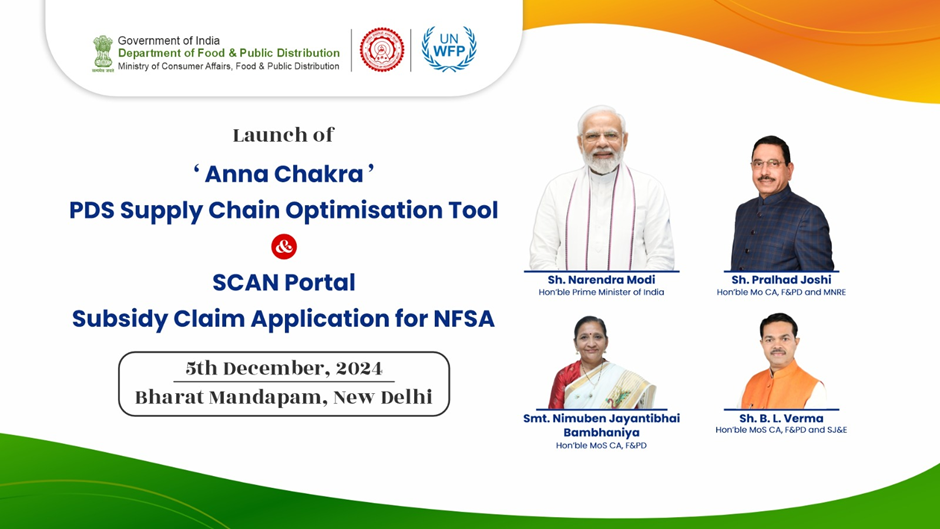- Courses
- GS Full Course 1 Year
- GS Full Course 2 Year
- GS Full Course 3 Year
- GS Full Course Till Selection
- MEP (Mains Enrichment Programme) Data, Facts
- Essay Target – 150+ Marks
- Online Program
- GS Recorded Course
- NCERT- First Ladder
- Polity
- Geography
- Economy
- Ancient, Medieval and Art & Culture AMAC
- Modern India, Post Independence & World History
- Environment
- Governance
- Science & Technology
- International Relations and Internal Security
- Disaster Management
- Ethics
- Current Affairs
- Indian Society and Social Issue
- CSAT
- 5 LAYERED ARJUNA Mentorship
- Public Administration Optional
- ABOUT US
- OUR TOPPERS
- TEST SERIES
- FREE STUDY MATERIAL
- VIDEOS
- CONTACT US
Union Government Launched Anna Chakra and SCAN Portal for Public Distribution System Optimization
Union Government Launched Anna Chakra and SCAN Portal for Public Distribution System Optimization
07-12-2024

- On 5th December 2024, Shri Pralhad Joshi, Union Minister of Consumer Affairs, Food and Public Distribution, and New & Renewable Energy, launched two important initiatives aimed at modernizing India’s Public Distribution System (PDS) and subsidy claim mechanisms:
- ‘Anna Chakra’ – A tool for PDS Supply Chain Optimization.
- SCAN Portal – A Subsidy Claim Application for the National Food Security Act (NFSA).
- These initiatives are designed to enhance the efficiency, transparency, and cost-effectiveness of India’s largest food security program, which serves over 81 Crore beneficiaries.
Anna Chakra: PDS Supply Chain Optimization Tool
- ‘Anna Chakra’ is a state-of-the-art PDS Supply Chain Optimization tool developed by the Department of Food and Public Distribution (DFPD) in collaboration with:
- World Food Programme (WFP)
- Foundation for Innovation and Technology Transfer (FITT), IIT-Delhi
- The tool uses advanced algorithms to identify the most efficient routes for the transportation of food grains across the country, ensuring optimal movement of food from warehouses to Fair Price Shops (FPS).
- The supply chain involves multiple stakeholders, including farmers, warehouses, and retailers, making this tool essential for improving the logistics of the Public Distribution System (PDS).
Objectives and Impact of Anna Chakra:
- Efficiency Enhancement: The tool will help improve the speed and efficiency of the PDS, making the movement of food grains quicker and more reliable.
- Cost Savings: By optimizing delivery routes, the initiative aims to reduce fuel consumption, logistics costs, and time spent on transportation, with an estimated Rs. 250 Crore savings annually.
- Environmental Benefits: The optimization will reduce the carbon footprint of PDS transportation, contributing to lower emissions due to the decreased use of fuel and shorter travel distances.
- Wide Coverage: The route optimization has been conducted across 30 states, covering 4.37 lakh Fair Price Shops and approximately 6700 warehouses.
The initiative also integrates with several platforms:
- Freight Operations Information System (FOIS): To optimize railway transportation.
- PM Gati Shakti Platform: To map geo-locations of FPSs and warehouses for better coordination.
These integrations will allow for a seamless and streamlined logistics network across the country, benefiting millions of people who rely on PDS.
SCAN Portal: Subsidy Claim Application for NFSA:
- The SCAN portal is another key initiative designed to simplify and streamline the subsidy claim process under the National Food Security Act (NFSA).
- The portal enables a single window submission for food subsidy claims by states, with features like:
- Claim Scrutiny and Approval: Ensuring quick review and processing of subsidy claims by the Department of Food and Public Distribution (DFPD).
- End-to-End Workflow Automation: The portal automates the entire process, ensuring fast and efficient release and settlement of food subsidies using rule-based processing.
- The SCAN portal will ensure:
- Transparency: States can submit their subsidy claims and track progress through a centralized platform.
- Faster Processing: The automation of processes reduces delays and allows for quicker settlements of food subsidies.
Significance of These Initiatives
- Optimizing the World's Largest Food Security Program: India’s Public Distribution System is one of the largest in the world, and initiatives like ‘Anna Chakra’ will significantly enhance its efficiency, making it more responsive to the needs of beneficiaries.
- Economic Impact: By optimizing transportation routes and automating subsidy claims, these tools can lead to substantial cost savings for the government while improving service delivery to citizens.
- Environmental Impact: Reduced fuel consumption and optimized logistics will contribute to sustainable practices within the public distribution system.
These tools are expected to make India’s food distribution system more resilient, efficient, and future-ready in the face of evolving logistical challenges.
What is the Public Distribution System (PDS)?The Public Distribution System (PDS) in India is a government-run program designed to provide essential food items, like rice, wheat, sugar, and kerosene oil, at subsidized rates to economically vulnerable populations.
Evolution:
Objectives of PDS:
Significance of TPDS:
Importance of PDS:
Functioning of PDS:The process involves four key steps:
|
Must Check: Best IAS Coaching In Delhi
UPSC Prelims Result 2024 Out: Expected Cut Off & Other Details, UPSC Prelims 2024 Answer with Explanation, Daily Prelims Quiz, Daily Current Affairs, MONTHLY CURRENT AFFAIRS TOTAL (CAT) MAGAZINE, Best IAS Coaching Institute in Karol Bagh, Best IAS Coaching Institute in Delhi, Daily Mains Question Answer Practice, ENSURE IAS UPSC Toppers, UPSC Toppers Marksheet, Previous Year Interview Questions, UPSC Syllabus
India’s EV Mission: Progress Delayed, Not Denied
India’s EV Mission: Progress Delayed, Not Denied



